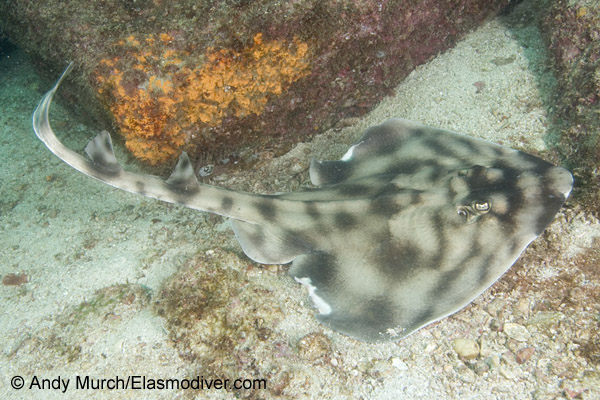| Trygonorrhinidae (Banjo rays, Fiddler rays) |
| 83 cm (male/unsexed); 97 cm (female) |
|
reef-associated; marine; depth range 1 - 200 m |
| Eastern Pacific: California, USA to Mexico, records to Peru probably misidentifications. |
|
Vertebrae: 149-150. Spiral valve count: 8-10. Broad disc is about as wide as it is long; dorsal surface covered with numerous, small to large, scattered, stellate prickles; a single median row of enlarged thorns running along the mid-back; a broad, short snout; small, blunt, pebble like teeth; a dorsal fin that originates closer to the pelvic fin bases than to the caudal fin origin; a thick tail and a moderately large, rounded caudal fin without a distinct lower lobe. Tooth count: 60-75/60-75.
Coloration: The dorsal surface is sandy brown to dark gray, with several prominent black bars, and lighter below with dark spots on the posterior edge of the pectoral fins. |
| Generally in rocky areas mainly shallower than 10 m, moves offshore onto soft bottoms in autumn and winter; but may also be found on sandy bottoms (Ref. 37955, Ref. 114953). Reported from tide pools (Ref. 12951). Relatively docile, harmless rays that are easily approached by divers (Ref. 48844). Feeds mainly on mollusks and crustaceans (Ref. 37955). Ovoviviparous (Ref. 50449), with 4 to 11 pups in a litter (Ref. 51576). Maturity size of males at 64-70 cm TL, females at 57-77 cm TL; birth size at 15-18 cm TL (Ref. 114953). Seldom buries itself in sand. This species is a commercially important part of artisanal fisheries (Ref. 114953).
Etymology: The genus name comes from the Greek za, meaning intensive, and pteryx, meaning fin, in reference to the vertical fins being larger than those of skates. The species name comes from Latin, meaning made rough, in reference to the numerous stellate prickles on its back. (Ref. 48844). |
|
Data deficient (DD); Date assessed: 05 January 2015 Ref. (130435)
|
| harmless |
Source and more info: www.fishbase.org. For personal, classroom, and other internal use only. Not for publication.
